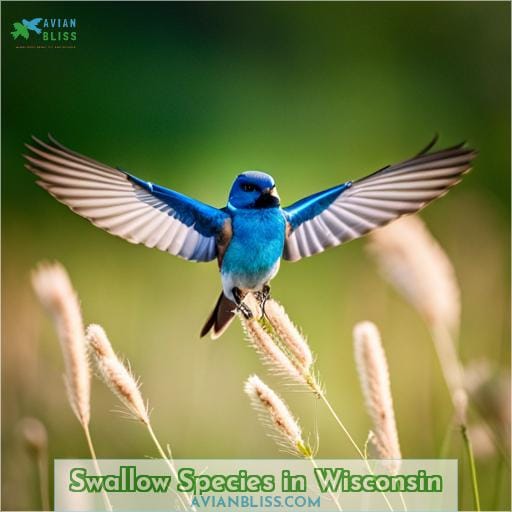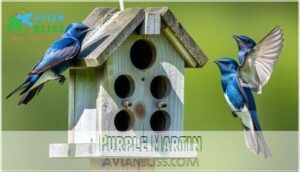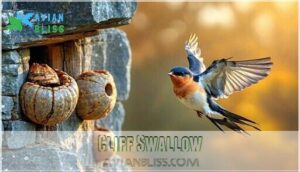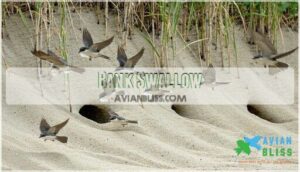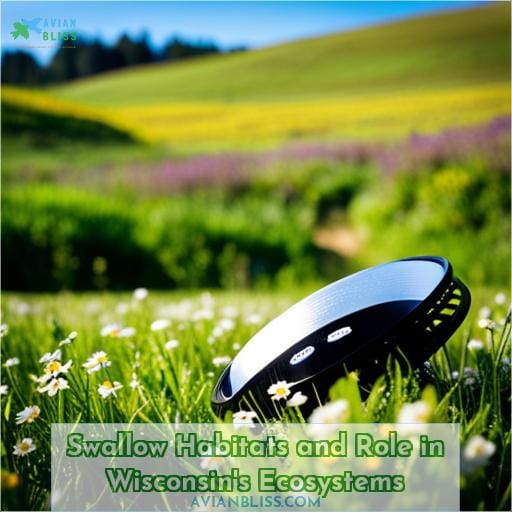This site is supported by our readers. We may earn a commission, at no cost to you, if you purchase through links.
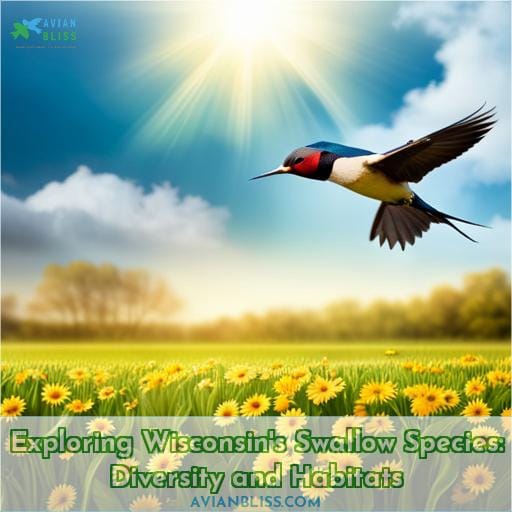
From the quiet shores to the heart of rural expanses, swallows in Wisconsin paint a vibrant mosaic of diversity and resilience.
In the heart of this captivating avian tapestry, the barn swallow emerges as a herald of spring. Their fluttering displays light up the horizon with a splash of orange. As the days grow longer, you’ll encounter the Northern Rough-winged Swallow, blending seamlessly with rugged cliffs and riverside havens.
The Purple Martin graces the scene with its ethereal charm, while the Tree Swallow, a nimble artist of the air, captures your gaze in a dance of fluid motion. High above, the Cliff Swallow weaves intricate nests, embodying nature’s ingenuity.
Dive into the intimate world of these aerial companions as we journey through their habitats, nesting rituals, and pivotal roles within Wisconsin’s ecosystems.
From the bustling cities to the tranquil countryside, the swallows of Wisconsin extend an invitation to explore their lives and embrace the sense of belonging that comes with understanding the delicate balance of nature’s choreography.
Table Of Contents
- Key Takeaways
- Swallow Species in Wisconsin
- Barn Swallow
- Northern Rough-winged Swallow
- Purple Martin
- Tree Swallow
- Cliff Swallow
- Bank Swallow
- Swallow Habitats and Role in Wisconsin’s Ecosystems
- Frequently Asked Questions (FAQs)
- How do swallow species in Wisconsin contribute to the state’s avian diversity and ecosystem health?
- What is the significance of the adaptations observed in Barn Swallows living near highways, particularly in relation to their wing feathers and skeletons?
- How does the migratory behavior of the Northern Rough-winged Swallow differ from other swallow species in Wisconsin, and why is its foraging behavior notable?
- Could you elaborate on the ecological role that swallows, as aerial insectivores, play within Wisconsin’s diverse habitats?
- What factors have contributed to the decline of Bank Swallows in North America, and how does their breeding occurrence in Wisconsin compare to other swallow species mentioned in the article?
- Conclusion
Key Takeaways
- Swallows in Wisconsin contribute to avian diversity and ecosystem health.
- Swallows exhibit various adaptations, such as shorter wings and evolved skeletons.
- Swallows play a crucial role in pest control by consuming hundreds of mosquitoes daily.
- Conservation efforts are crucial to preserve nesting sites and habitat for swallow species.
Swallow Species in Wisconsin
Amid the diverse tapestry of habitats, these agile fliers significantly enrich the avian population, each with its distinct characteristics and role.
Swallows grace Wisconsin’s skies with their remarkable presence during the summer breeding season. From the vibrant Barn Swallow with its dark blue upperparts and reddish-orange underside, often nesting in human-made structures, to the graceful Cliff Swallow, recognized by its rust-red forehead and cream belly.
The Tree Swallow, adorned in iridescent feathers, finds solace near water bodies, while the elusive Bank Swallow, in its light brown attire, nests sparingly in the state.
Swallow migration patterns reveal their behavioral adaptations for survival, particularly the Barn Swallow’s affinity for human areas. However, conservation challenges persist, with some species facing declines due to reduced nesting sites.
Balancing human interaction with these nesting preferences is crucial to preserving these dynamic contributors to Wisconsin’s avian ecosystem.
Barn Swallow
Navigating through the intriguing world of Wisconsin’s Barn Swallows, you’ll discover their captivating life within their chosen habitats and nesting sites. As these skilled aviators engage in their intricate mating rituals and life cycles, their presence brings not only wonder but also a potential for damage, revealing the nuanced interactions between these birds and their environment.
Habitat & Nesting
Nestled within Wisconsin’s diverse landscapes, these agile avian insectivores find their havens, contributing significantly to the state’s vibrant ecosystem.
Wetland Wonders: Swallows in Wisconsin are masters of wetland ecology, gracefully swooping low over water bodies. Their foraging habits create mesmerizing displays as they snatch insects in mid-flight, maintaining a delicate balance in the ecosystem.
Strategic Nesting: Amidst competition for nesting sites, swallows strategically choose locations like buildings, bridges, and boxes. This nesting colony camaraderie strengthens their numbers and ensures the survival of their fledglings.
Incredible Migrations: Swallows undertake remarkable migration patterns, departing for warmer shores as Wisconsin’s seasons shift. These journeys underscore their tenacity and adaptation skills, as they face diverse challenges during their remarkable travels.
Human Connection: Human landscapes offer new opportunities for swallows, as they adapt to urban environments. Their adaptability fosters a unique connection between humans and nature, reminding us of the interconnectedness of all species within our shared habitat.
Mating & Life Cycle
Imagine witnessing the vibrant dance of courtship as iridescent birds glide gracefully over crystal-clear waters, a captivating spectacle that marks the beginning of their remarkable life cycle.
Barn swallows engage in intricate courtship behaviors, showcasing their agility and prowess. Males demonstrate their prowess through aerial acrobatics and offering carefully selected nesting materials.
Once courtship ends, nest construction begins. The female meticulously weaves mud and grass into a sturdy cup-shaped nest, often tucked beneath eaves or bridges.
The pair’s harmonious synergy continues during incubation and fledgling development. Successful breeding hinges on factors like nest location, protection from predators, and an ample insect supply. As seasons shift, these agile birds embark on epic migrations, further underscoring the marvel of their life cycle.
Damage
In the midst of this avian tapestry, envision the fragile equilibrium disrupted by the havoc inflicted upon delicate ecosystems. Swallows, those agile aerial insectivores, play a pivotal role in maintaining environmental balance.
Yet, the economic fabric and agricultural harmony are not spared. Their migration routes trace across the United States, gracing the Lake Michigan coastline. Mitigation strategies and urban coexistence efforts gain urgency as we strive to harmonize their feeding behavior with our human domains.
Northern Rough-winged Swallow
Picture this: a bird with unassuming brown feathers, inconspicuous in appearance, yet playing a vital role as an insect-hunting aerial acrobat over Wisconsin’s landscapes during the summer months. The Northern Rough-winged Swallow, with its light brown upper body and white underside, is a migratory wonder.
Foraging low over water bodies, these swallows engage in graceful group dynamics. They dart and swoop with a synchronized finesse that’s mesmerizing to behold. Their soft vocalizations add an enchanting melody to the surroundings as they navigate the air currents.
When fall arrives, these unassuming birds embark on an incredible journey, leaving Wisconsin behind and flying all the way to Mexico. As summer fades, the young of the Northern Rough-winged Swallow embark on their maiden migration, guided by instincts honed through generations.
Purple Martin
Now, delve into the realm of avian diversity as you encounter the magnificent Purple Martin, the largest of North American swallows, showcasing a striking deep blue plumage in males and a subtle gray elegance in females.
As summer graces Wisconsin, these charismatic birds embark on an extraordinary journey, undertaking the Purple Martin Migration that spans from their breeding grounds to the lush landscapes of South America for the winter.
Known for their remarkable colony behavior, these sociable creatures nest together, often using man-made nesting alternatives such as specialized boxes to foster their vibrant communities.
Amidst their acrobatic movements in the air, Purple Martins also display intricate nesting preferences. They exhibit a curious habit of ingesting calcium-rich items like eggshells to bolster their health and eggshell strength.
While their conservation status is of least concern, the marvel of witnessing these aerial experts in action encourages us to embrace their role in Wisconsin’s avian tapestry, inspiring continued efforts to preserve the habitats that sustain them.
Tree Swallow
Imagine standing by the tranquil shores of a shimmering lake, where the air is alive with the iridescent dance of a certain blue-winged creature – the Tree Swallow. Its feathers catch the sunlight, resembling shards of a summer sky, captivating all who behold it.
As you observe, here are five intriguing aspects of the Tree Swallow’s world:
Migration Marvel: These agile birds embark on remarkable journeys, migrating to Wisconsin during the warmer months and traveling south for the winter, crossing vast distances with remarkable precision.
Iridescent Wonders: Cloaked in greenish-blue iridescence, their feathers create a stunning spectacle as they glide gracefully above water bodies, an awe-inspiring display of nature’s beauty.
Wetland Haven: Tree Swallows find solace in wetland habitats, where their acrobatic flights mirror the rippling water below, perfectly suited for their insect-rich diet and dynamic lifestyle.
Nesting Prowess: Seeking out suitable nesting sites, these swallows often choose man-made nesting boxes, showcasing their adaptability to coexist with human landscapes while raising their young.
Nature’s Pest Control: An essential role in nature’s balance, Tree Swallows excel as aerial insectivores, curbing populations of pesky insects, and contributing to a healthier ecosystem.
Witnessing these enchanting creatures in their natural habitat offers a glimpse into the intricate tapestry of life that they weave within Wisconsin’s ecosystem.
Cliff Swallow
Explore the vibrant palette of colors adorning the Cliff Swallow, from its rust-red forehead to its cream belly, as it embarks on its journey from Wisconsin to the South American landscapes.
This distinctive swallow, with its dark plumage and cream underbelly, brings a touch of nature’s artistry to the skies. In Wisconsin, these agile aerialists breed before setting out on their remarkable migration.
They create gourd-shaped nests on cliffs, overhangs, and even human structures, showcasing their adaptability.
Dipping and diving in the air, Cliff Swallows adeptly snatch insects, contributing to the delicate balance of Wisconsin’s ecosystem. However, the conservation status of this species requires attention, as habitat loss and other factors threaten their populations.
Strategies that blend bird control and property preservation can offer solutions to prevent potential damage.
Bank Swallow
As you gaze upon the landscape, a light brown bird with a distinctive white chest band catches your eye, fluttering near a sandy bank. This is the Bank Swallow (Riparia riparia), a rare breeder in Wisconsin. Its light brown plumage and chest band set it apart as it breeds in the region’s scattered colonies.
Unfortunately, these colonies have witnessed a decline, partly due to habitat loss caused by human activities. Bank Swallows exhibit fascinating nesting behavior, creating burrows in the steep banks along water bodies.
These burrows not only provide shelter but also reflect their crucial role as insectivores.
To ensure the survival of these remarkable birds, habitat preservation efforts are imperative, aligning with the Migratory Bird Treaty Act. Despite the challenges, fostering breeding success and safeguarding their habitats remain essential for the conservation of Bank Swallows and the diversity they bring to Wisconsin’s avian tapestry.
Swallow Habitats and Role in Wisconsin’s Ecosystems
In Wisconsin’s diverse landscapes, contributing to the state’s rich avian realm, these agile creatures stand out: over 500 bird species thrive, all benefiting from the ecological significance these feathered insectivores bring.
These avian wonders collectively consume countless insects, playing a pivotal part in maintaining the delicate balance of Wisconsin’s ecosystems. Wetland benefits amplify as swallows frequent these areas, their foraging reducing pesky insect populations.
Migration patterns unveil their impressive journeys, connecting continents as they navigate between breeding and wintering grounds. Amid human coexistence, these swallows find shelter in bridges and buildings, a testament to their adaptability.
Conservation efforts gain importance to preserve these edge habitat dwellers, ensuring the skies remain alive with the swift grace of these marvelous birds.
Frequently Asked Questions (FAQs)
How do swallow species in Wisconsin contribute to the state’s avian diversity and ecosystem health?
Swallow species in Wisconsin enhance the avian tapestry and enhance ecosystem vitality. Aerial insectivores like Barn Swallows assist in pest control, while Purple Martins and others bring dynamic beauty, highlighting the state’s ecological harmony.
What is the significance of the adaptations observed in Barn Swallows living near highways, particularly in relation to their wing feathers and skeletons?
Discover how Barn Swallows near highways in Wisconsin thrive. Shorter wings aid in survival after storms, enhancing flight efficiency and cold resilience.
How does the migratory behavior of the Northern Rough-winged Swallow differ from other swallow species in Wisconsin, and why is its foraging behavior notable?
The migratory behavior of the Northern Rough-winged Swallow sets it apart from other swallow species in Wisconsin. Unlike other swallows in Wisconsin, it spends its summers here and then migrates south.
Notably, it forages low over water bodies in sociable groups, creating a captivating spectacle of nature’s rhythm.
Could you elaborate on the ecological role that swallows, as aerial insectivores, play within Wisconsin’s diverse habitats?
Delving into Wisconsin’s avian tapestry, swallows emerge as vital aerial insectivores. Their captivating flight not only adds to the spectacle but also curbs insect populations. Each day, a single swallow devours hundreds of mosquitoes, fostering harmony in Wisconsin’s diverse habitats.
What factors have contributed to the decline of Bank Swallows in North America, and how does their breeding occurrence in Wisconsin compare to other swallow species mentioned in the article?
Bank Swallows in North America decline due to habitat loss, including gravel pit destruction and altered river dynamics. Breeding is rare in Wisconsin; habitat degradation affects nesting sites. Comparatively, other swallow species thrive, reflecting diverse adaptability.
Conclusion
As you explore the fascinating world of swallows in Wisconsin, their diversity and importance become evident.
Picture this: the iconic Barn Swallow with its distinctive forked tail, embodying the arrival of spring. This charismatic species has adapted remarkably to human landscapes, a fact underscored by the Nebraska study revealing their shorter wings near highways.
But the world of Wisconsin’s swallows doesn’t stop there. The Northern Rough-winged Swallow, with its brown and white plumage, adds an air of mystery as it forages low over water bodies, often in lively groups.
Meanwhile, the Purple Martin, the largest North American swallow, graces the scene with its striking deep blue hue.
Wisconsin’s watersides are adorned by the iridescent Tree Swallow, and the Cliff Swallow, with its rust-red forehead, contributes to this avian tapestry. Even the Bank Swallow, in its rarity, plays a part in this story. As you read about their habitats and behaviors, their importance as aerial insectivores becomes clear.
In this rich ecosystem, swallows serve as vital players, controlling insect populations and maintaining the balance. As they gracefully glide through the air, they contribute to the intricate web of life in Wisconsin.
Indeed, swallows in Wisconsin hold the key to maintaining ecological harmony, reminding us of the delicate dance of nature.

